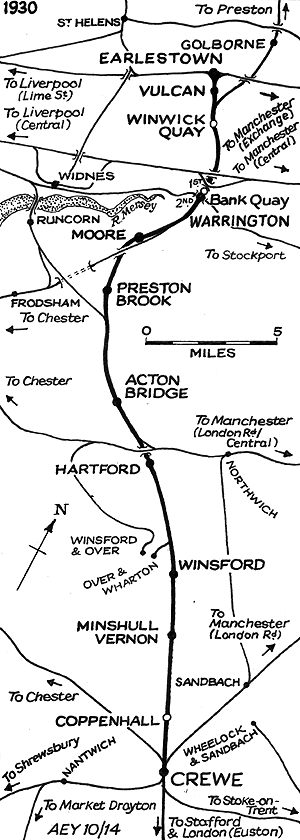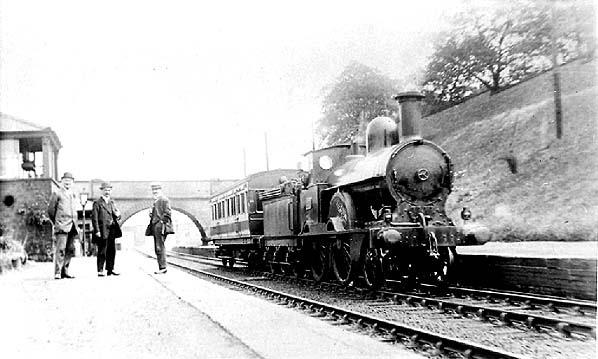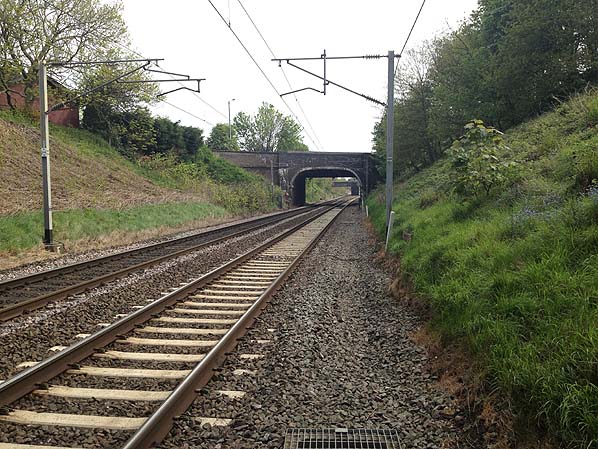Notes: Moore was situated on the Grand Junction Railway (GJR) which opened from Newton to Birmingham on the 4 July 1837. The GJR was Britain’s first trunk railway and had been supported by many of the same individuals who had been behind the Liverpool & Manchester Railway (L&M). The GJR connected with the L&M at Newton Junction (which later became Earlestown Junction) thereby providing a link between Birmingham, Liverpool and Manchester. From 9 April 1838 the line connected with the London & Birmingham Railway (LBR) at Birmingham Curzon Street allowing passengers to travel between London, the Midlands and the great industrial and port cities of the north-west.
 Moore station opened with the line on 4 July 1837. It was located on the south side of Runcorn Road on the western edge of its namesake village. The double-track line passed under Runcorn Road and the station was located in a cutting. At the time of opening access was via a path down to track level on the west side of the line. At that time there would not have been raised platforms and only a simple cottage-like building which would have housed the booking facilities. Moore station opened with the line on 4 July 1837. It was located on the south side of Runcorn Road on the western edge of its namesake village. The double-track line passed under Runcorn Road and the station was located in a cutting. At the time of opening access was via a path down to track level on the west side of the line. At that time there would not have been raised platforms and only a simple cottage-like building which would have housed the booking facilities.
Two houses were also provided at road level for station staff.
On 16 July 1846 Preston Brook became part of the London & North Western Railway (LNWR). By this time the station was on a route that stretched from London to Carlisle.
The March 1850 timetable showed only 2 up and 4 down trains called at Moore Monday-to-Saturday and no trains called on Sundays.
By the 1860s the line had been extended through to Glasgow creating an Anglo-Scottish route that later became known as the West Coast Main Line.
By the 1870s the station had raised platforms. The main facilities were on the down platform (Earlestown direction). They consisted of a modest single-storey brick building with a pitched roof. There was a similar building on the up platform that housed waiting facilities.
At the mid-point of the down platform there was Saxby & Farmer signal box.
The December 1895 timetable showed 4 up and 5 down services Monday-to-Saturday. There was 1 up and 2 down trains on Sundays.
By the end of the nineteenth century an access path had been provided that linked the up platform directly to Runcorn Road on the east side of the line.
By 1907 the signal box had been replaced with an LNWR structure located to the north of Runcorn Road, west of the line.
On 1 January 1917 the station was one of many that closed both as a wartime economy measure and to release manpower for military service; it did not reopen until 1 February 1919.
The July 1922 timetable showed 7 up and 9 down services Monday-to-Friday. On Saturdays 2 extra down services ran and no trains called at Moore on Sundays.
On 1 January 1923 Moore became part of the London Midland & Scottish Railway (LMS). The LMS timetable for the summer of 1932 showed 7 up and 10 down trains Monday-to-Saturday as shown in the table below.
| Up Trains Summer 1932 |
Destination |
Down Trains Summer 1932 |
Destination |
| 7.45am |
Hartford |
6.57am |
Wigan North Western |
| 10.22am |
Acton Bridge |
7.51am |
Earlestown |
| 1.05pm |
Crewe |
8.39am |
Newton-le-Willows |
| 1.32pm |
Crewe |
10.49am |
St Helens |
| 3.30pm |
Over & Wharton |
12.30pm (Saturdays Excepted) |
Warrington Bank Quay |
| 6.13pm (Saturdays Excepted) |
Over & Wharton |
12.56pm (Saturdays Only) |
Warrington Bank Quay |
| 7.45pm |
Acton Bridge |
2.50pm |
St Helens |
| 10.20pm (Saturdays Only) |
Acton Bridge |
3.57pm |
Newton-le-Willows |
| |
|
5.38pm |
Newton-le-Willows |
| |
|
7.16pm |
Earlestown |
| |
|
9.53pm |
Warrington Bank Quay |
After the outbreak of the Second World War on 3 September 1939 passenger services were reduced throughout the country. As Moore had so few services the LMS closed it on 1 February 1943. It was, however, used by railway staff until 1952.
The station had been completely demolished by the 1960s. The station house survived and was still in use as a private residence in November 2014. The line was electrified in the early 1970s.
The line through Moore is still a busy part of the Anglo-Scottish West Coast Main Line.

Tickets from Michael Stewart route map by Alan Young.
Sources:
- Britains First Trunk Line - The Grand Junction Railway - Norman W Webster - Adams & Dart 1972
- Lost Stations of North West England – Paul Wright – SLP 2011
- Railway Passenger Stations in Great Britain - A Chronology - Michael Quick - RCHS 2009
To see other stations on the Grand Junction Railway between Earlestown and Crewe click on the station name: Vulcan Halt, Winwick Quay, Warrington Dallam Lane, Warrington Bank Quay (1st), Preston Brook, Minshull Vernon and Coppenhall
The 8D Association - Dedicated to promoting the history of South Lancashire and North Cheshire railways. Web Site |






.jpg)
.jpg)
 Moore station opened with the line on 4 July 1837. It was located on the south side of Runcorn Road on the western edge of its namesake village. The double-track line passed under Runcorn Road and the station was located in a cutting. At the time of opening access was via a path down to track level on the west side of the line. At that time there would not have been raised platforms and only a simple cottage-like building which would have housed the booking facilities.
Moore station opened with the line on 4 July 1837. It was located on the south side of Runcorn Road on the western edge of its namesake village. The double-track line passed under Runcorn Road and the station was located in a cutting. At the time of opening access was via a path down to track level on the west side of the line. At that time there would not have been raised platforms and only a simple cottage-like building which would have housed the booking facilities. 

 Home Page
Home Page